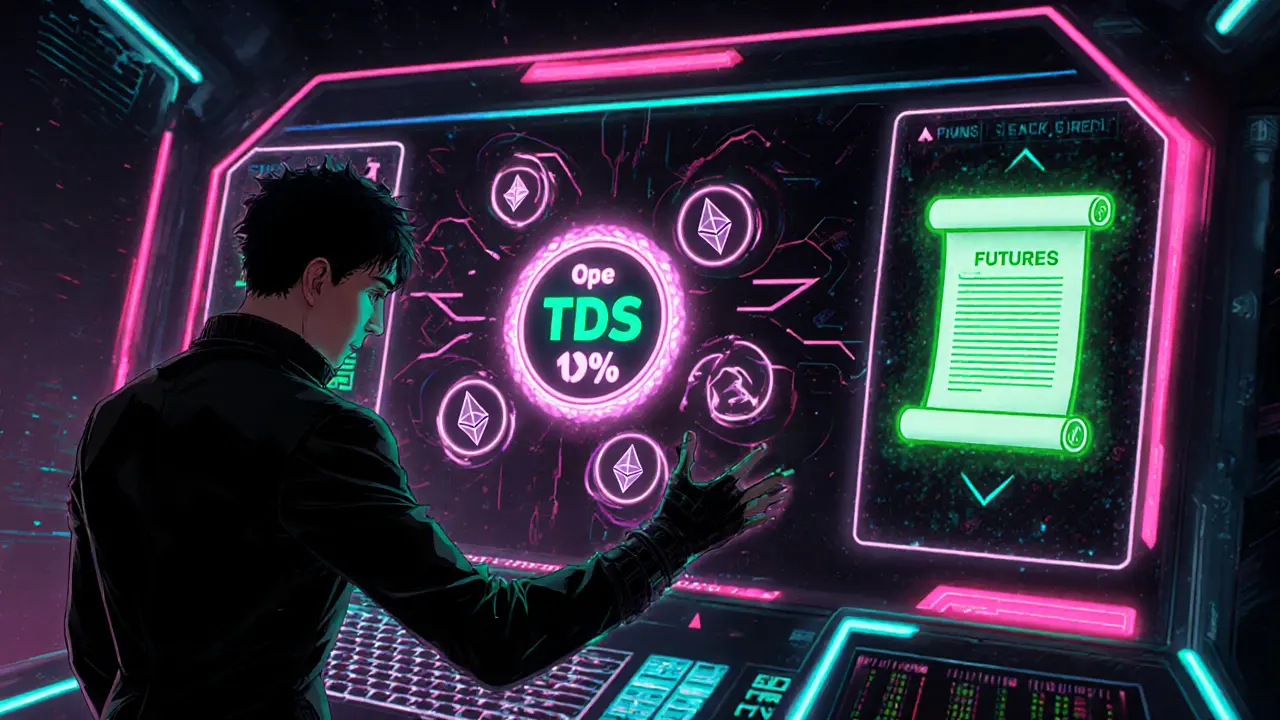India's No‑Loss Offset Rule: How It Impacts Crypto Traders

Crypto Tax Calculator: No-Loss Offset Rule Impact
Tax Calculator
This calculator demonstrates how India's no-loss offset rule affects your crypto trading tax liability. Input your trade details and see how the 30% tax on gains and 1% TDS impacts your net result.
Key Takeaways
- The no‑loss offset rule bars crypto losses from reducing taxable gains.
- All crypto gains are taxed at a flat 30% plus surcharge and cess.
- 1% TDS applies on every crypto transfer above INR 10,000, hurting cash flow.
- Losses cannot be carried forward or offset against salary, business income, or other assets.
- Traders are shifting to futures, offshore platforms, or reducing activity to manage the tax burden.
What the No‑Loss Offset Rule Actually Says
When the Indian government introduced the No Loss Offset Rule (India) a provision that bars cryptocurrency losses from being used to offset gains, traders felt the heat. Codified under Section 115BBH(2)(b) the clause of the Income Tax Act that defines crypto taxation, the rule makes every profit taxable while refusing any relief for a loss.
How India’s Crypto Tax Framework Works
India treats every virtual digital asset - from Bitcoin and Ethereum to NFTs and newer tokens - as a Virtual Digital Asset (VDA) any crypto‑related token that the tax code classifies as a financial asset. The tax rate is a flat 30% on any gain, regardless of income level or holding period. On top of that, a surcharge and health & education cess push the effective rate a little higher.
Every time you move crypto worth more than INR 10,000 in a financial year, the exchange deducts a 1% Tax Deducted at Source (TDS) a withholding tax collected by the exchange on each transaction. For high‑frequency traders, this can turn into a sizable cash‑flow drain, even before any profit is realized.
Only the acquisition cost of the crypto can be claimed as a deduction. Operational expenses - gas fees, exchange commissions, or wallet costs - are not allowed. The loss‑offset prohibition means that a trader who makes INR 100,000 on one trade and loses INR 80,000 on another still owes INR 30,000 in tax (30% of the gain), with no credit for the loss.
Why the Rule Is a Game‑Changer Compared to Traditional Investments
In the equity market, investors can offset gains with losses within the same category and even carry forward unutilized losses for up to eight years. Business losses can be set off against most other income, except salary. Crypto, however, sits in its own tax silo. The India crypto tax environment offers no loss relief, no carry‑forward, and no ability to reduce other income streams.
This asymmetric burden makes crypto trading feel riskier than buying shares. A trader who loses money on a speculative coin ends up paying tax on unrelated crypto profits, effectively raising the net tax on the portfolio.

Real‑World Impact on Traders
Platforms like CoinSwitch have warned that the 2025 regulations are “stricter than ever”. Traders report spending hours compiling spreadsheets to satisfy Schedule VDA the reporting schedule in ITR‑2 and ITR‑3 for crypto transactions. The form can’t be filed using the simple ITR‑1, forcing many small investors to seek professional help.
Consider a typical month for an active trader:
- Buy BTC for INR 150,000.
- Sell part of it for INR 200,000 (gain = INR 50,000).
- Trade BTC for ETH, incurring a loss of INR 30,000.
- Pay 1% TDS on each transfer (roughly INR 3,500 total).
The tax bill is 30% of the INR 50,000 gain = INR 15,000, plus the TDS already withheld. The INR 30,000 loss does nothing to lower the tax. In effect, the trader’s net cash flow is negative despite an overall profit of INR 20,000.
Because of this, many traders are moving to crypto futures, which the law treats as derivatives and therefore escape the VDA‑specific TDS. Others are opening accounts on overseas exchanges, but that opens them up to a 20% Tax Collected at Source (TCS) under the Liberalised Remittance Scheme if they remit more than INR 7 lakh per year.
Compliance Challenges and Penalties
Failure to disclose crypto holdings can trigger the newly introduced 60% tax under Section 158B the clause that penalises undisclosed virtual digital assets. The penalty applies retroactively from 1 February 2025, meaning any hidden crypto from earlier years can now be taxed at a steep rate.
Tax advisors at Dinesh Aarjav & Associates say that the crackdown has increased demand for specialized crypto tax services. Documentation now must include:
- Exact acquisition price for each token.
- Date and value of every sale, swap, or spend.
- Proof of TDS deposits made by the exchange.
- Records of staking rewards, airdrops, hard forks, and mining income.
Without this, the tax department can levy interest, penalties, and even prosecution for willful evasion, as highlighted by Cointelegraph’s analysis.
Comparison: Crypto Tax vs. Equity Tax in India
| Aspect | Cryptocurrency (VDAs) | Equity/Stocks |
|---|---|---|
| Tax Rate | Flat 30% + surcharge & cess | 15% long‑term capital gains (after 1‑yr) or 10% short‑term |
| Loss Offset | Not allowed across any crypto transaction | Allowed within same asset class; can carry forward 8 years |
| TDS | 1% on every transfer > INR 10,000 | None on equity trades |
| Reporting Form | Schedule VDA in ITR‑2/ITR‑3 | Schedule CG in ITR‑1/ITR‑2 |
| Carry‑Forward Losses | No provision | Up to 8 years for capital losses |
| Penalty for Non‑Disclosure | 60% tax under Section 158B | Up to 200% tax for willful concealment |

Strategies Traders Are Using to Cope
Given the harsh backdrop, traders have started to adapt:
- Futures & Options: These are classified as derivatives, so the 30% VDA tax and 1% TDS don’t apply. However, they bring their own risk profile.
- International Exchanges: Moving assets abroad can avoid Indian TDS, but the 20% TCS on remittances and potential double‑tax treaties must be considered.
- Tax‑Optimised Record Keeping: Using automated crypto tax software that pulls transaction data directly from wallets reduces manual errors.
- Loss Harvesting in Other Jurisdictions: Some traders maintain small holdings in countries where crypto losses can offset gains, then repatriate profits.
None of these solutions are perfect, and many require professional advice to stay compliant.
Future Outlook
Budget 2025 didn’t soften the rule; instead, it added higher penalties for undisclosed assets. Tax experts predict the no‑loss offset provision will stay, making crypto less attractive for retail traders. Industry bodies continue to lobby for a more balanced framework, arguing that the current regime stifles innovation and pushes activity offshore, which could ultimately reduce tax receipts.
If reforms happen, they will likely aim to align India’s approach with global norms - allowing loss offset within the crypto class and possibly introducing a holding‑period exemption. Until then, every trader should treat each crypto transaction as a taxable event that can’t be offset by any loss.
Bottom Line
The no‑loss offset rule, together with a flat 30% tax and 1% TDS, makes crypto trading in India a high‑cost activity. Traders must keep meticulous records, consider alternative instruments, and possibly seek professional tax help to avoid costly penalties.
Can I offset crypto losses against my salary?
No. The no‑loss offset rule forbids using cryptocurrency losses to reduce taxable salary income. Only crypto gains are taxed, and losses are ignored.
Is the 1% TDS refundable if I end the year with a net loss?
The 1% TDS is a withholding amount. If your total tax liability is lower than the TDS collected, you can claim a refund while filing your return.
Do futures trades escape the no‑loss offset rule?
Futures and options are treated as derivatives, not as VDAs. Therefore, the 30% flat crypto tax and loss‑offset restriction do not apply, but profits from futures are taxable under business income.
What penalty applies for not reporting crypto holdings?
Under Section 158B, undisclosed virtual digital assets can be taxed at 60% of the asset’s fair market value, along with interest and possible prosecution.
How should I keep records for Schedule VDA?
Maintain a spreadsheet that logs for each transaction: token name, acquisition cost, date, sale/transfer value in INR, and TDS amount. Export data from your exchange and keep wallet screenshots for verification.
Marina Campenni
June 14, 2025 AT 07:29The no‑loss offset rule really squeezes small traders; every profit gets taxed while the losses just sit there, untouched. It feels like the tax code is punishing risk‑taking in a way that’s hard to justify.
Irish Mae Lariosa
June 18, 2025 AT 03:48While the legislation purports to bring clarity to crypto taxation, it simultaneously demolishes any semblance of fairness for the average investor; the flat 30 % rate on gains, irrespective of holding period, is a draconian measure that disregards fundamental investment principles. Moreover, the prohibition on loss offset leaves traders in a perpetual state of negative cash flow, even when their overall portfolio shows modest appreciation. The mandatory 1 % TDS on every transfer above INR 10,000 exacerbates the problem, effectively taxing traders before any profit materialises. In practice, this creates an environment where the cost of compliance outweighs the potential returns, prompting a mass exodus to offshore platforms or derivative instruments. It is an overtly punitive approach that could stifle innovation and drive capital abroad.
Nick O'Connor
June 22, 2025 AT 00:06India’s crypto tax framework, as stipulated under Section 115BBH(2)(b), imposes a flat thirty‑percent levy on gains; additionally, a surcharge and cess are levied, thereby increasing the effective tax burden; the mandatory one‑percent TDS applies to every transaction exceeding ten thousand rupees, which, for high‑frequency traders, translates into a substantial cash‑flow drain; the rule further disallows any loss offset, meaning that even substantial trading losses do not alleviate tax liabilities; consequently, traders must meticulously document each transaction, ensuring compliance with Schedule VDA in ITR‑2/ITR‑3.
Jessica Cadis
June 25, 2025 AT 20:25Exactly, the punitive nature of the rule forces many to seek alternatives, and the lack of a loss‑offset provision basically transforms crypto trading into a tax‑trap for the average enthusiast.
Shikhar Shukla
June 29, 2025 AT 16:43It is incumbent upon the Indian tax authorities to recognise that the present provisions are incongruous with the principles of equity and proportionality; the absolute denial of loss offset not only contravenes international best practices but also imposes an undue fiscal burden on traders who operate within the legal framework; such a stance may be deemed as discouraging legitimate market participation, thereby impeding the broader objectives of financial inclusion and technological advancement.
Deepak Kumar
July 3, 2025 AT 13:01Friends, if you’re feeling the squeeze, remember there are tools out there-crypto tax software can auto‑populate Schedule VDA, and futures contracts let you sidestep the TDS nightmare; it’s all about staying informed, keeping clean records, and maybe consulting a tax pro to navigate the maze without getting burned.
Miguel Terán
July 7, 2025 AT 09:20From a broader perspective, the Indian regime’s insistence on a monolithic thirty‑percent tax, coupled with a draconian no‑loss offset rule, mirrors a governmental anxiety about the nascent digital asset space; this anxiety manifests in heavy‑handed compliance demands, such as the obligatory one‑percent TDS on every transfer exceeding the ten‑thousand‑rupee threshold, which in turn creates a perpetual liquidity strain for high‑frequency traders; consequently, many market participants are gravitating towards derivatives-futures and options-that are classified separately, thereby escaping the VDA‑specific tax regime; simultaneously, an influx of capital is being funneled to offshore exchanges, despite the looming twenty‑percent TCS on remittances above seven lakh rupees; the cumulative effect is a bifurcated ecosystem where domestic traders either adapt via sophisticated record‑keeping and tax‑optimisation strategies or abandon the Indian market altogether in favour of more hospitable jurisdictions.
Shivani Chauhan
July 11, 2025 AT 05:38That’s spot‑on; I’ve started using an automated tracker to pull every trade into a spreadsheet, which has saved me countless hours and prevented me from missing the dreaded TDS deductions.
Deborah de Beurs
July 15, 2025 AT 01:57Honestly, if you’re not already moving your positions to futures, you’re basically throwing money away; the tax code makes it crystal clear that staying in spot crypto is a losing game.
Sara Stewart
July 18, 2025 AT 22:15In practice, the VDA classification triggers a tax‑treated event per transaction, which, when combined with mandatory TDS, inflates the effective tax rate well beyond the nominal thirty percent, especially for high‑turnover strategies.
Laura Hoch
July 22, 2025 AT 18:34One could argue that the tax architecture reflects a deeper societal tension between innovation and control, where the state’s appetite for revenue clashes with the individual’s pursuit of financial sovereignty, ultimately forcing a philosophical reckoning on the nature of ownership in the digital age.
Hailey M.
July 26, 2025 AT 14:52Oh, the no‑loss offset rule, what a masterpiece of bureaucratic brilliance! It takes the excitement out of crypto trading and replaces it with a soul‑crushing tax nightmare. Every time you think you’ve made a clever swing, the tax department swoops in with a flat thirty‑percent levy that makes your profit feel like a joke. Then, just for fun, they slap a one‑percent TDS on every transfer over ten thousand rupees, draining your wallet before you even see a gain. And let’s not forget the glorious inability to offset those inevitable losses, because why would the state ever want you to keep more of your hard‑earned money? You end up paying tax on phantom profits while your actual bottom line screams ‘negative’. It’s as if the policymakers sat around a table saying, “How can we make this as painful as possible?” The result is a mass exodus to offshore platforms, where traders whisper about “the freedom” they once dreamed of. Meanwhile, the Indian tax officials bask in the glow of increased paperwork and compliance fees. The irony is palpable: a rule designed to increase revenue ends up pushing capital out of the country, eroding the very tax base it sought to protect. Developers are left scratching their heads, wondering whether to code for a market that’s essentially being strangled. Advisors are cashing in on panic, offering pricey services to navigate the labyrinthine Schedule VDA. And the average trader? They’re left holding a ledger of transactions, a dwindling bank balance, and a deep, existential dread about the future of digital finance in India. In short, the no‑loss offset rule is the tax world’s version of a bad breakup-painful, confusing, and ultimately, a catalyst for moving on.
Schuyler Whetstone
July 30, 2025 AT 11:11this whole tax thing is just a huge overhype and sucks.
David Moss
August 3, 2025 AT 07:29Some say the tax clampdown is merely a front; the real agenda might be to force crypto assets into the hands of shadowy elites, while the average citizen is left to navigate an ever‑changing maze of regulations that only a few can truly decipher